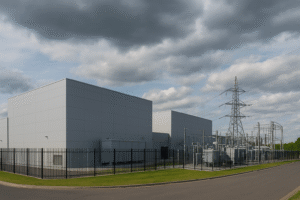The European AI pipeline is truly at a crossroads. The demand for AI data centre capacity is meeting the very real constraints that infrastructure & market dynamics show. This rush to build the specialised facilities that are in need of next-gen computing pushes us to ask a crucial question: are we forging a sustainable AI pipeline, or are we inflating an AI-driven infrastructure investment risks bubble?
Understanding this demands digging deep into the technical realities when it comes to power, the financial drivers of speculative building, & the innovative solutions that are coming to anchor this growth to a realistic path. So, this article goes through this complex dilemma, examining the incredible surge in demand.
The Surge of AI Demand & Europe’s Data Centre Expansion
The arrival of AI-driven workloads has absolutely changed Europe’s data centre scene. It has triggered a never-before-seen rush for capacity and power. We need to clearly see the quantitative impact of AI, note the major investments coming into the continent, and address the serious/real-world infrastructure limits that are holding back this expansion:
Quantifying AI’s Impact on Data Centre Capacity and Power Needs
Current projections show European data centre electricity consumption will more than double by 2030. It is reaching a massive 168 TWh – that’s over 5% of total electricity use – primarily due to AI compute requirements. Furthermore, leading hyperscale projects such as Microsoft’s €3.2B investment in German sites & Google’s €1B in Finland show the race to make AI-ready infrastructure. One that is capable of supporting rack densities up to 100kW/rack, a nearly tenfold leap above legacy standards.
Consequently, conventional air cooling is seeing a replacement with liquid & immersion techniques. This is to maintain ultra-low PUE as regions like Dublin & London see grid strains, sometimes taking 80% of local power. By 2025, up to a third of the global capacity of data centre will power AI, with Europe sitting at the heart of this explosive transformation. So, this shows the urgent need for a robust AI data centre foundation.
Major European AI Data Centre Projects and Investment Trends
Europe is witnessing a historic influx of capital into AI data centre mega-projects. This is with global hyperscalers & major investors targeting rapid expansion across new & traditional markets. Furthermore, the UK is leading the charge with Vantage’s £12 billion Wales campus & Blackstone’s £10 billion Northumberland AI-ready site. They are set to become among Europe’s largest. In Sweden, Brookfield is making a $10 billion/ 750MW AI data centre in Stockholm, specially made for ultra-high density compute and sustainability.
Moreover, Portugal’s Start Campus SINES hub is effectively doubling national capacity. This is with 1.2GW for AI, cloud, and HPC, powered 100% by renewables. Meanwhile, France’s exascale campus by MGX, Nvidia, & Mistral will anchor sovereign AI/ low-carbon compute. Additionally, the funding comes from sovereign wealth such as InvestAI’s €200B EU plan, venture capital, & hyperscaler reinvestment. This is with growing activity in the Nordics for green energy and in Central Europe for regulatory ease & connectivity. Also, hotspots include:
- The UK,
- Nordics (Sweden/Finland/Norway),
- Portugal,
- and France.
They are each optimizing for AI demand surges and next-gen infrastructure. This further highlights the massive scale of AI-driven infrastructure investment risks.
Infrastructure Bottlenecks: Real Limits Behind Rapid Expansion
Europe’s fast AI data centre expansion is seeing a host of infrastructure challenges. These are definitely limiting growth and delaying the timelines of projects. In addition, power grid capacity imposes huge barriers. In important centers like London, Dublin, etc., the electricity networks are fully stretched, and in 2023, Dublin had to stop the connection of new data centres due to a lack of grid resources. Moreover, integrating renewable energy adds complexity. This is because the unstable supply from wind & solar challenges grid stability and raises the competition for clean energy contracts among operators.
Land availability stands to be another obstacle, with suitable plots in/around major metropolitan regions becoming difficult to secure. Additionally, permitting & regulatory approvals are slow. This is with some UK data centre projects facing wait times of 18-24 months. Other factors include the outstanding opposition of the local community, especially in highly populated cities facing difficulties due to the shortage of water. People are more concerned about the resources being used and the environmental impact. The global supply chain has also suffered, as critical equipment such as semiconductors, electrical components, and HVAC may be delayed for up to months. It pushes many European projects to source the main materials from overseas and ultimately slows down the progress. This shows the fragile nature in the face of the massive demand for AI data centre capacity.
Bubble Signals – Financial, Technical, & Policy Warning Signs
A ton of capital is coming into the sector, and the build-out plans are incredibly ambitious, making a real gold rush feeling. Meanwhile, some analysts are seriously sounding the alarm. The high valuations & speculative nature of some capacity buildouts definitely point toward potential bubble conditions. So, this segment focuses on the speculative investment risks, the danger of overbuilding, and more:
Speculative Investment and Overvaluation Concerns in Data Centre Markets
Europe’s AI data centre market is witnessing widespread concerns when it comes to investment & inflated valuations. These are solidly driven by hype rather than solid fundamentals. Furthermore, the estimated market value when it comes to AI data centres in Europe is expected to rise from $236 billion in 2025 to nearly $934 billion by 2030, outpacing the actual growth of enterprise compute demand. Some major players/assets are flagged as up to 25% overvalued by analysts. This is especially where expansion plans are dependent on ambitious AI deployment projects that may not materialize at scale.
Moreover, financing models keen on pre-leased future capacity and heavy use of debt carry bubble-like risks. The useful economic life of AI chips is dropping to as little as five years. This raises the threat of rapid obsolescence & asset write-downs. Additionally, industry watchdogs like the Knight Frank & CBRE show the dangers – if demand for hyperscale AI flattens, Europe can witness a correction similar to the telecom crash. This is with stranded investments and fire-sale exits. Oversupply in key hubs, in combination with frothy valuations & aggressive pro-AI funding, is now a top issue for institutional investors and global analysts. These are concerned about the AI-driven infrastructure investment risks that lead to a data centre overbuild.
Underutilization Risks: Are AI Data Centres Being Overbuilt?
Despite strong headlines when it comes to Europe’s data centre boom, there is an increasing risk that capacity growth is outpacing the actual AI workload penetration. Underutilization is emerging as a sector-wide issue. Furthermore, industry surveys show operators plan to commission 47MW of new capacity per operator in 2025. This is nearly triple the levels of just three years ago. In reality, actual usage does not always square with such ambitious buildouts. Moreover, a recent report by CBRE pointed out that some campuses at key UK & Frankfurt locations are operating at utilization rates less than 55%, while hyperscale sites are pre-leasing space years in advance for AI that may not ramp up as expected.
Stranded asset risk is also increasing because data centres built for generative AI/large-scale ML face delays in the actual workload migration, and lean on urgent enterprise AI adoption that is not fully realized. Operators increasingly retrofit their existing legacy estates to adapt, warning that inefficient resource allocation will lead to idled infrastructure, forcing downsizing, resale, or other uses. Perspectives from industry groups show that unless AI apps accelerate in line with capacity expansion, Europe may very well see a glut of campuses with suboptimal returns & delayed economic impact. This will confirm the dangers of data centre overbuild.
Regulatory and Energy Policy Uncertainties Amplifying Market Fragility
Regulatory and energy policy frameworks that are evolving are sharply amplifying market fragility for Europe’s AI data centre sector. Newly proposed EU energy directives need data centres over 500kW to publicly report:
- Energy usage,
- Carbon intensity,
- And waste heat plans.
This raises compliance complexity and operational costs starting in 2026. Furthermore, multiple member states are proposing strict power curbs & environmental impact standards. This is while the Emissions Trading System Phase 4 can introduce new carbon pricing mechanisms for hyperscale operators.
Moreover, uncertainty over the future availability of cheap renewable energy, as demand spikes, competes with national decarbonization goals & grid congestion limits power allocation. Some regions that include Dublin & Amsterdam have already paused/restricted new campus builds. This is to resolve sustainability & local energy security concerns. Additionally, industry analysts warn that even little policy shifts, such as reduced incentives or sudden changes to land use, can stall years of planning. It can prompt developers to invest in new markets or pivot strategies between projects. Regulatory risk is also becoming like a decisive factor in location strategy/profitability forecasts/ the overall design of AI-ready European data centre portfolios. This is pushing many to re-evaluate their AI-driven infrastructure investment risks.
Infrastructure Realities & Innovation Fighting Overbuild Risks
While the market does show signs of potential overextension, a concurrent sort of wave of technological/operational innovation is actually working to mitigate these risks. These advances aim to majorly increase efficiency, secure robust power, and more. So, let’s take a look:
Advances in Energy Efficiency and Modular Data Centre Designs
Energy efficiency & modular design are absolutely reshaping Europe’s next-generation of AI data centre facilities. Operators are now deploying dynamic power management, intelligent airflow, etc., which have helped leading sites reach Power Usage Effectiveness ratios below 1.2. This majorly reduces overall energy consumption. Furthermore, modular & prefabricated data centre architectures allow for immediate deployment that can actually outpace traditional construction by 40%. It also enables flexible expansion, efficiently scaling workloads, or relocating assets. It minimizes sunk cost risk if market conditions change.
Waste heat recovery is also a crucial innovation – projects like the THUNDER initiative & Infomaniak’s Swiss campus capture and upgrade low-grade server heat. It channels it into urban district heating networks or nearby buildings. Moreover, this approach turns potential waste into a resource. It helps with the city’s energy needs and assists facilities in meeting the EU Green Deal carbon neutrality targets for 2030. Additionally, by pairing modular scaled builds with circular energy methods, European data centres are not just boosting efficiency, they are building adaptability & sustainability right into their core operations. This makes the prospect of data centre overbuild less severe.
Power Solutions: Grid Modernization and On-Site Renewables Integration
European operators are making advanced power solutions a priority to support the insane growth of AI data centres. These cleverly blend grid modernization with onsite renewables. Further, partnerships between data centre firms & major utilities are accelerating – UK-based projects in areas like South Wales & East London have secured co-investment agreements for grid infrastructure upgrades. It increases available megawatts and allows faster site commissioning. On-site green energy campuses in Sweden and Portugal are aiming for 100% renewable supply. This is by using large-scale solar farms & wind turbines strategically integrated with facility demand.
Moreover, emerging microgrid designs and high-capacity battery storage systems make way for these centres to operate independently during grid failures/peak demand. As a result, it reduces downtime risks and smooths out the variable renewable supply. Facilities are also experimenting with multi-hour storage and grid services. This enables participation in demand response markets and balances reserves. These innovations not only give protection to operations but also support compliance with EU carbon standards. It also shows the region’s transition toward energy self-sufficiency in the time of hyperscale AI infrastructure, helping to manage the requirement for AI data centre capacity.
Demand Forecasting and Capacity Management Tools Leveraging AI
AI-powered forecasting platforms in Europe use deep learning models/ time-series analysis/ real-time telemetry data from IT & facility sensors. This accurately predicts surges in demand and guides expansion decisions at a granular level. These systems synthesize:
- Workload patterns,
- Customer reservation data,
- Market energy prices,
- And regulatory changes.
It simulates future scenarios, actively aiding operators to prevent costly overbuilds. For instance, hybrid cloud analytics with reinforcement learning algorithms optimizes server allocation & cooling cycles. It adjusts thousands of variables hourly across several geographic sites.
Furthermore, dynamic capacity scaling makes way for operators to redirect resources to peak demand locations or instantly spin down infrastructure when usage dips. This maximizes utilization and controls overhead. Moreover, advanced platforms such as those used by Nordic & UK hyperscales have shown a 22–28 % reduction in idle capacity. This leads to multi-million euro savings and a smaller carbon footprint. Additionally, these approaches, backed by automated dashboards, enable stakeholders to delay/cancel excess builds before breaking ground. It aligns investment cycles with actual demand reality, lowers risks of asset stranding & market saturation, and addresses the data centre overbuild concern.
The Path Forward: Scenarios and Strategic Recommendations
The thin line between explosive growth & speculative risk is what determines the future of Europe’s AI Data Centre landscape. We need to consider key scenarios and outline proactive strategies that will help stakeholders prepare for what’s next, with the goal of a robust pipeline rather than an expensive crash. So, let’s do that in this section:
Scenario 1: Sustained Growth Realizing Europe’s AI Infrastructure Potential
Sustained growth in the development of Europe’s AI Data Centre infrastructure requires a coordinated foundation of policy, technical, and financial conditions. These should be distinct from headline expansion. On the demand side, EU-wide initiatives such as the AI Continent Plan and AI Growth Zones in the UK have started to:
- Harmonize regulations,
- Fast-track permitting,
- And allow for dedicated compute regions.
These “Special Compute Zones” lower bureaucratic hurdles and allow for co-located renewable energy infrastructure. It anchors data centre clustering in high-innovation/ low-carbon hubs.
Green power is a baseline expectation: 92% of European operators are investing to reduce emissions; gigawatt-scale contracts are locked for 24/7 clean energy through:
- On-site renewables,
- Integrated district heating,
- And energy storage.
Performance is measured through mandatory public sustainability disclosures. Moreover, realizing AI-driven capacity depends on the continuous flow of capital, while infrastructure financing is shifting to collaborative models. EU-backed pan-European bonds, ring-fenced AI funds, R&D tax credits, and milestone-based release of private equity prevent the formation of speculative bubbles. Governments enforce carbon and resilience standards as orchestrators. Operators deploy circular energy systems, leveraging AI-enabled dynamic resource management. And finally, investors focus on utilization, local value, & long-term returns based on actual enterprise, SME, and public sector usage. This grounds expansion in climate planning and economic resilience takes the risk out of AI-driven infrastructure investment.
Scenario 2: Market Correction with Consolidation Phase
A market correction in Europe’s AI data centre industry could be triggered by a mismatch. This is between projected AI workload demand & actual enterprise adoption, abrupt regulatory obstacles such as limits on energy use, or a spike in the cost of financing. Furthermore, a bubble burst will result in distress, forcing operators to mothball or repurpose barely-used hyperscale facilities. This leads to asset write-downs and layoffs. Leases locked in at peak prices may well be renegotiated or terminated.
Moreover, new construction will take a back seat to retrofitting and modular upgrade programs in existing facilities. It will focus on improving utilization rates. Poorly performing campuses will be repurposed as edge, cloud, or sustainability pilots. Investment will shift away from speculative mega-projects to secured, milestone-based, and joint-venture solutions with an increase in green bonds. Additionally, new build debt financing will be replaced by asset-backed securities once profitability is proven. Merger and acquisition activity will also increase with a consolidation of distressed campuses. Government incentives will additionally become tighter, focusing on local skills, green metrics, and “shovel-ready” projects. This is the possible outcome of an unmanaged Data Centre Overbuild.
Strategic Actions by Stakeholders to Understand the Dilemma
Successfully navigating Europe’s AI Data Centre dilemma requires stakeholders to adopt a deeply data-driven and cross-sector approach. Developers will have to use digital twin modeling & predictive analytics. It simulates whole-of-project scenarios, including lifecycle carbon impact, water consumption, & urban utility stress-well in advance of new builds. Furthermore, policymakers will need to establish integrated planning channels for:
- Distributed energy procurement,
- Baselining of emissions,
- And streamlined permitting.
This is so that new facilities transparently meet environmental and circular economy standards.
Moreover, industry-wide collaboration is crucial, extending to the ecosystem partnerships where European and UK operators co-invest in backup grids and best-practice sharing. Further, establishing regional data center resilience boards for real-time data sharing mitigates the risks. Financiers and investors should also support clear milestone-based funding models. It focuses on utilization and community benefit over pure occupancy. Embedding granular scenario modeling, policy coordination, and risk-sharing via a consortium in this way keeps the sector agile. It also prevents data centre overbuild while ensuring long-term value for all participants.
To Wrap Up
Europe’s data centre sector is currently going through a complex/dual-edged growth story. It is driven by the huge appetite for AI. The massive capital & capacity being used clearly show a potent technological pipeline, yet the immense scale also shows real AI-driven infrastructure investment risks. It also shows the very real possibility of a data centre overbuild. So, to make sure the continent’s digital infrastructure stands to be both cutting-edge & economically sound, the industry needs to pivot from speculative enthusiasm to nuanced/data-driven planning.
Making a balance between rapid innovation in cooling & modular design with caution against over-leveraged/underutilized capacity is the challenge right now. This strategic equilibrium makes sure of sustainable infrastructure development and secures Europe’s stance as a global AI leader. If you want to discuss crucial areas like these with the industry leaders and make the right collaboration to be miles ahead in this race, we have a summit coming right up. It is the 3rd Data Centre Design, Engineering, & Construction Summit in London, U.K., on 2-3 December 2025. Learn more and register right away!




